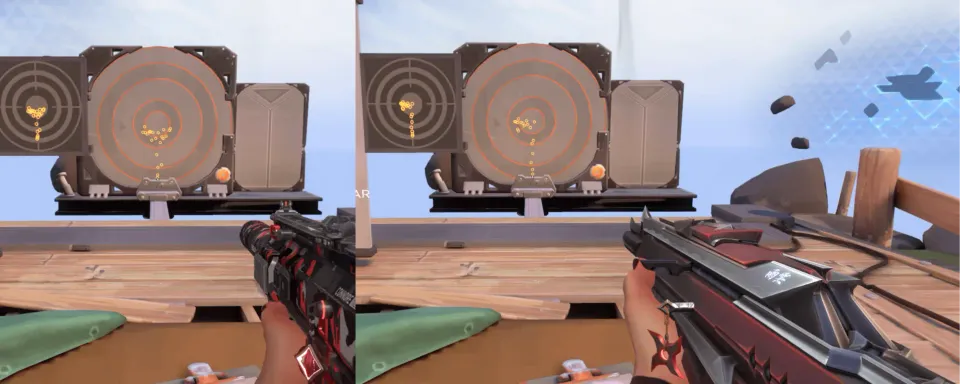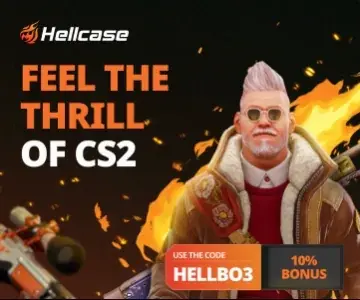- Mkaelovich
Guides
09:08, 14.11.2024

Mastering recoil control and spray patterns is essential for any shooter, and Valorant is no exception. By honing this skill, your in-game success will significantly improve. This guide will help you understand the basics of Valorant recoil patterns, teach you how to manage spray patterns for primary weapon types, and provide tips and exercises to master and refine these vital skills for ranking up in Valorant.
In this article:
- Overview: The Importance of Sprays and Recoil Control
- Understanding Sprays in Valorant
- Weapon-Specific Spray Patterns
- Recoil Control Techniques
- Step-by-Step Guide for Practicing Recoil Control on the Range
- Spray Control Practice Routine
- Common Mistakes in Recoil Control
- Advanced Techniques
- Spray Patterns and Recoil Control in Competitive Scenarios
- Examples of Pro Players with Excellent Spray Control
Overview: The Importance of Sprays and Recoil Control
Why is Recoil Control Important?
Being able to control recoil in Valorant allows for consistent kills even in fast-paced combat when facing multiple opponents at once. A player who can control recoil gains a significant advantage over those who overlook this skill, as they can more effectively wield rifles like the Vandal and Phantom, which are the game’s most powerful yet challenging weapons to "tame."

Difference Between Spraying and Tapping
In Riot Games' shooter, there are multiple shooting methods: spraying (continuous shooting without a break), tapping (single shots), and bursting (series of 2-3 shots). Each has its pros and cons depending on the situation, so players should adapt to duels based on their experience. For instance, tapping is more effective at long range, while spraying is preferable at close range. The choice of weapon matters too, as the Odin, even with single shots, won’t be effective at long distances.

Understanding Sprays in Valorant
What is a Spray and Why is it Important?
If you've ever wondered, "Does Valorant have spray patterns?" the answer is a definite yes. This guide will show the spray patterns of each major weapon type.
A spray pattern is the recoil trajectory a weapon shows during prolonged firing. Knowing all spray patterns in the game and being able to predict and control them allows for hitting more targets, greatly impacting your stats and improving your chances of winning a match. Every weapon in Valorant has its unique spray pattern, which is crucial to know if you want to be among the best in the game.

Spray Patterns for Different Weapons (Examples: Vandal and Phantom)
The Vandal and Phantom are two premium rifles in Valorant and are the most popular among players. The Vandal is more powerful, meaning its recoil and spray pattern are harder to control compared to the Phantom, which has its advantages: it's easier to control and comes with a silencer.

- The Vandal’s spray pattern has pronounced vertical and horizontal recoil, making it harder to control than the Phantom. See the comparison above.
- Phantom: features more stable vertical and horizontal recoil, making it easy to control at close and medium ranges, but its damage drops after 15 meters.
The right mouse button provides an alternate fire mode for both the Vandal and Phantom. It slightly reduces recoil, but it also lowers fire rate by 10% and movement speed by 26%.
How Do Sprays in Valorant Differ from Other Shooters like CS?
Unlike the popular shooter Counter-Strike 2, where recoil patterns are more stable and can be memorized, Valorant introduces more randomness. This means that while you can learn the primary direction of recoil for main weapon types, you'll need to adjust to changes in the spray during shooting.
READ MORE: The biggest guide to Split Map Valorant
Weapon-Specific Spray Patterns
Below are the Valorant spray patterns for most primary weapons without using alternate fire modes, which for some weapons reduce recoil or change the fire mode from automatic to burst, as with the Bulldog and Stinger.
Below are the Valorant spray patterns for most primary weapons without using alternate fire mode, which for some weapons reduces recoil, while for others it changes the firing mode from automatic to burst, like with the Bulldog and Stinger.

Vandal

- Vandal Recoil Pattern: The first few shots go vertically upward with slight left or right deviations, then the recoil shifts to horizontal.
- Spray Situations: Effective in automatic mode at short and medium ranges.
- Tapping or Burst Situations: Single shots are ideal for long-range duels, as the weapon kills with a single shot. Burst shots (2-4 bullets) are effective at long and medium ranges.
Phantom

- Phantom Recoil Pattern: More manageable recoil, starting vertically with a slight right deviation, then shifting to horizontal to the left.
- Use in Different Situations: With higher firing speed and more stable recoil, the Phantom is suitable for close-range combat and short bursts at medium ranges. Tapping is ineffective, as the weapon loses damage after 15 meters.
Bulldog

- Bulldog Recoil Pattern: Similar to the Phantom’s pattern but more compact.
- Use in Different Situations: At long and medium ranges, it is recommended to switch to alternate mode, activating burst; at close range, use primary mode.

Ares

- Ares Recoil Pattern: Horizontal, noticeable right after the first shot, then continues with a right tilt and shifts to a vertical left.
- Use in Different Situations: Automatic mode only, as other modes are ineffective at any range, being suited for close combat.
Odin

- Odin Recoil Pattern: Similar to the Ares, but easier to control due to its higher fire rate and better shot grouping.
- Use in Different Situations: Automatic mode only, effective only at close and medium ranges.
Spectre

- Spectre Recoil Pattern: After seven shots, the vertical recoil shifts to horizontal, fluctuating both right and left.
- Use in Different Situations: Automatic mode only, effective solely at close range.

Stinger

- Stinger Recoil Pattern: Maximum recoil, making it almost impossible to control. Each shot raises the weapon higher, then the recoil shifts to a chaotic horizontal pattern.
- Use in Different Situations: Automatic mode up to 5 meters, then switch to burst mode to hit targets up to 10-15 meters.
Frenzy

- Frenzy Recoil Pattern: The first three shots are almost on point, after which the weapon rises significantly, starting a chaotic horizontal pattern.
- Use in Different Situations: Automatic mode within a range of 5-10 meters.
Recoil Control Techniques

Basic Recoil Control Mechanics
To control recoil in Valorant, players need to follow a few simple steps:
- Pull the crosshair down after the first few shots to compensate for vertical recoil.
- Adjust sideways movements based on the horizontal spray deviation, which begins after 5-8 shots.
Step-by-Step Guide for Practicing Recoil Control on the Range
- Open Valorant, click “Play,” and enter the range, located at the bottom left of the “Start” button under “Practice,” selecting “The Range.”
- Go to the distance-adjustable target located behind the spawn point.
- Theory: Choose a distance of 10-20 meters and pick a favorite weapon like the Phantom or Vandal by opening the shop with the B key (default). Shoot a bit to understand how the weapon behaves without control, using the target to track bullet trajectory and adjust distance.
- Practice: Start training on the target to understand the force required for effective spray control. Then return to the main area and press “Practice,” where mechanical bots will appear. Use what you’ve learned to take down targets while moving.
- Reinforcement: Select the “Eliminate” mode for 50 or 100 targets by pressing F3. Start and apply what you’ve learned by eliminating each target that appears randomly.
Recoil Adjustment for Medium and Long Ranges
At medium range, avoid full sprays, limiting yourself to 5-7 bullets, controlling each shot, especially with the Vandal. At long range, limit yourself to taps or bursts of two or three shots, as this will be more effective than a full spray, which is hard to control at such distances.

Spray Control Practice Routine
Exercises to Improve Vandal and Phantom Control
The Range is an excellent place to enhance recoil control for the Vandal and Phantom. Use various targets, especially those that display the trajectory of your bullets and allow distance adjustment. A few minutes of warm-up with these will suffice. Afterward, switch to Deathmatch and Team Deathmatch modes, focusing on your training goal. Emphasize recoil control, ignoring stats, as this is just one element of your training.
The Importance of Practice
Regular practice in the Range and Deathmatch/Team Deathmatch modes will help develop muscle memory, significantly improving your accuracy and stability in controlling the challenging Valorant Vandal spray pattern.

Common Mistakes in Recoil Control
- Over-correction: Many beginners adjust their crosshair too sharply due to insufficient understanding of in-game mouse sensitivity, leading to large misses.
- Panic Spray: In stressful situations, players may start spraying chaotically, relying on luck rather than skill.
- Lack of Crosshair Discipline: You need to keep your crosshair focused during a spray to make adjustments during duels.
How to Identify and Correct These Mistakes
Spend enough time in the Range to find the ideal sensitivity for yourself and feel how each weapon behaves during a spray. Spraying can become stressful when an enemy appears unexpectedly or when there is high pressure to perform well. Experience will help you handle stress better. Initially, remember not to rely on luck — focus on recoil control, even in tense situations. Crosshair positioning greatly affects your success in duels. Keep the crosshair at head or body level and stay focused during encounters.
Advanced Techniques

Crouch Spray
- Concept: Crouching while shooting reduces recoil and disrupts the enemy’s aim.
- How to Perform: Press the crouch key (Ctrl) during a spray, especially effective at close range.
- Advantages: Stabilizes recoil and complicates aiming for opponents. Use it sparingly to avoid predictability.
Counter-Strafing
- Concept: Instant stop for an accurate shot followed by movement.
- How to Perform: Move left, then sharply press the opposite key (right) to stop and shoot.
- Advantages: High accuracy while moving and reduced time spent as a stationary target.
Spray Patterns and Recoil Control in Competitive Scenarios
During a match, it’s crucial to adapt your shooting style to the situation. Here’s a quick guide on which shooting style is effective at certain distances:
- Close Range: Spray
- Medium Range: Spray or burst
- Long Range: Burst or single-tap

Examples of Pro Players with Excellent Spray Control
For inspiration, consider two players. The first is Tyson "TenZ" Ngo, who has retired from professional play but remains renowned for his settings and peripherals approach, controlling recoil like a pro and easily copes with the Vandal spray pattern. Another example is Adil "ScreaM" Benrlitom, known for his incredible one-taps. His headshot percentage in Counter-Strike remains one of the highest, even after switching to Valorant.
Comments
Upcoming Top Matches
Latest top articles







No comments yet! Be the first one to react